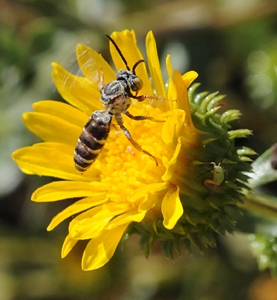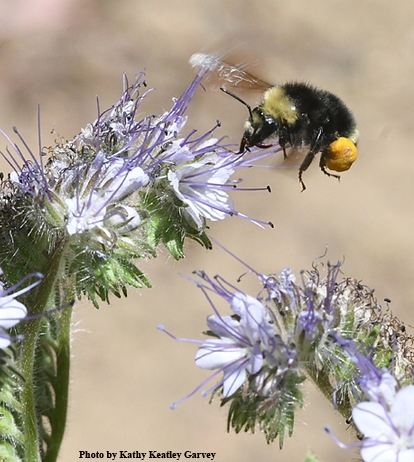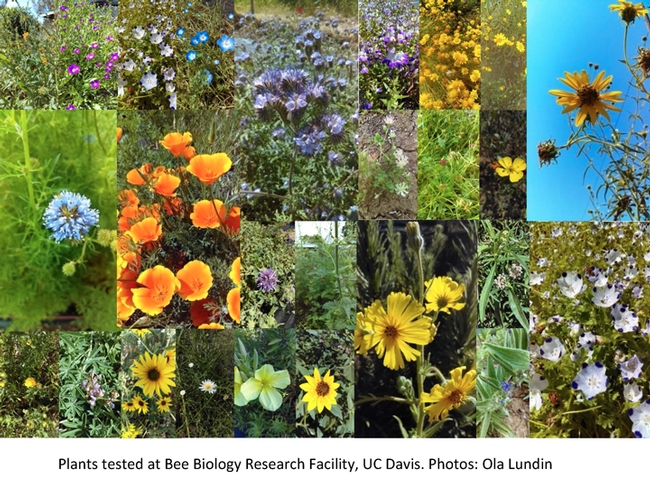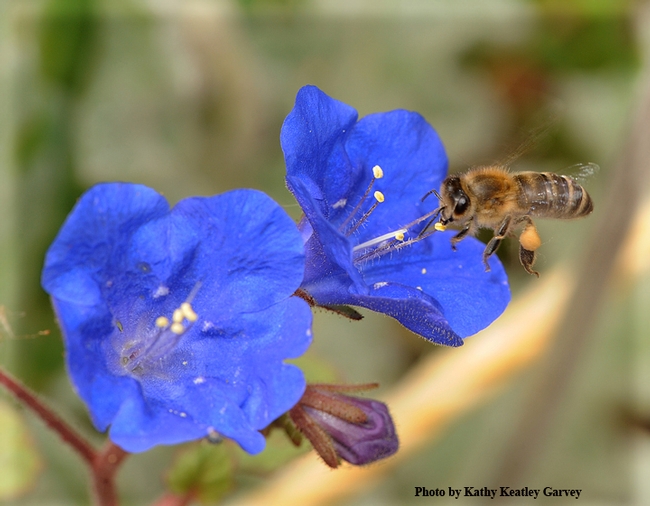- Author: Kathy Keatley Garvey



The two-year research, led by Ola Lundin, a former postdoctoral fellow in the Neal Williams lab, UC Davis Department of Entomology and Nematology and published in the Journal of Applied Ecology, details what plants proved most attractive to honey bees, wild bees and other pollinators, as well as what drew such natural enemies as predators and parasitic wasps.
The research, “Identifying Native Plants for Coordinated Habitat Management of Arthropod Pollinators, Herbivores and Natural Enemies,” is co-authored by Williams, professor of entomology and a Chancellor's Fellow at UC Davis; and project specialist Kimiora Ward of the Williams lab.
“I hope this study can inform selection of plants that support pollinators and natural enemies without enhancing potential pests,” said Lundin, first-author of the paper and now a postdoctoral fellow in the Department of Ecology, Swedish University of Agricultural Sciences, Uppsala.
“Planting wildflowers is a key strategy promoted nationally to support wild and managed bees,” said Williams. “Successful adoption of these plantings in agricultural landscapes will require that they not only support pollinators but that they also avoid supporting too many pests. Plant selection going forward will need to balance multiple goals of pollinators pest management and other functions. This research is a first step on the path to identifying plants that will meet these goals."
The three scientists, who conceived the ideas and developed the methodology for the research project, established 43 plant species in a garden experiment on the grounds of the Harry H. Laidlaw Jr. Honey Bee Research Facility at UC Davis. They selected plant species that were drought-tolerant; native to California (except for buckwheat, Fagopyrum esculentum, known to attract natural enemies and widely used in conservation biological control); and, as a group, covered a range of flowering periods throughout the season.

“For early season bloom, Great Valley phacelia (Phacelia ciliata) was a real winner in terms of being attractive for both wild bees and honey bees,” Lundin said. “Elegant Clarkia (Clarkia unguiculata) flowers in late spring and was the clearly most attractive plant for honey bees across the dataset. The related Fort Miller Clarkia (C. williamsonii) was also quite attractive for honey bees and had the added benefit that a lot of minute pirate bugs visited the flowers.”
Lundin said that common yarrow (Achillea millefolium) “attracted “attracted the highest numbers of parasitic wasps but also many herbivores, including Lygus bugs.”
“In general a lot of parasitic wasps were found on Asteraceae species (the daisy family) and this was a somewhat surprising result considering that they have narrow corollas, and for parasitic wasps relatively deep corollas that can restrict their direct access to nectar. Under the very dry conditions in late summer, Great Valley gumplant (Grindelia camporum) and Vinegarweed (Trichostema lanceolatum) both performed well and attracted high numbers of wild bees.”
The team found that across plant species, herbivore, predator and parasitic wasp abundances were “positively correlated,” and “honey bee abundance correlated negatively to herbivore abundance.”
The take-home message is that “if you're a gardener or other type of land manager, what you'd likely prefer would be a mix of some of the most promising plant species taking into account their individual attractiveness for these arthropod groups, plus several more factors including costs for seed when planting larger areas,” Lundin said.
“Plant choice can also depend on how you weigh the importance of each arthropod group and whether you are interested in spring, summer or season-long bloom,” Lundin added. Those are some of the questions that the Williams lab plans to explore in future projects.

Williams praised the “uniquely capable team that came together.”
“Ola is an emerging leader in considering integrated management of pests and pollinators and Kimiora is a known expert in developing regionally-relevant plant materials to support pollinators,” Williams said. “They and some talented UC Davis undergraduates--notably Katherine Borchardt and Anna Britzman--compiled a tremendously useful study.”
The overall aim of the study “was to identify California native plants, and more generally plant traits, suitable for coordinated habitat management of arthropod pollinators, herbivores and natural enemies and promote integrated ecosystem services in agricultural landscapes,” the researchers wrote.
More specifically, they asked:
- Which native plants among our candidate set attract the highest abundances of wild bees, honeybees, herbivores, predators, and parasitic wasps,
- If the total abundances of arthropods within these functional groups across plant speacies are related to the peak flowering week, floral area, or flower type of the focal plant species, and
- If the total abundances of arthropods within these functional groups are correlated to each other across plant species.
“A first critical step for design and implementation of multifunctional plantings that promote beneficial arthropods while controlling insect pests is to identify suitable plant species to use,” the authors wrote in their abstract. “We aimed to identify California native plants and, more generally, plant traits suitable for the coordinated management of pollinators (wild bees and honey bees), insect herbivores and arthropod natural enemies (predators and parasitic wasps).”
At the time, the Laidlaw grounds included nearly 50 bee colonies: some 20 to 40 honey bee colonies, and eight managed research colonies of the yellow-faced bumble bee, Bombus vosnesenkii.
The project received funding from the USDA Resources Conservation Service, USDA Agricultural Marketing Service, USDA National Institute of Food and Agriculture and a Swedish foundation for scientific research, the Carl Tryggers Stiftelse for Vetenskaplig Forskning.




